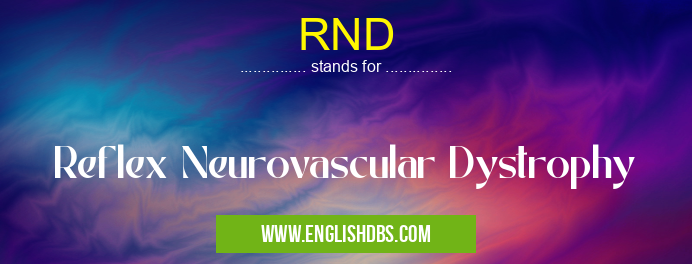What does RND mean in NEUROLOGY
Reflex Neurovascular Dystrophy (RND) is a neurological disorder characterized by extreme pain and impaired sensation in the limbs. The condition may affect both arms and legs, leading to muscle weakness, poor coordination, and reduced function of the affected areas. RND can result from a variety of causes, but its exact cause is not known. It is most commonly seen in children and adolescents, though it can also occur in adults.

RND meaning in Neurology in Medical
RND mostly used in an acronym Neurology in Category Medical that means Reflex Neurovascular Dystrophy
Shorthand: RND,
Full Form: Reflex Neurovascular Dystrophy
For more information of "Reflex Neurovascular Dystrophy", see the section below.
Essential Questions and Answers on Reflex Neurovascular Dystrophy in "MEDICAL»NEUROLOGY"
What are the symptoms of RND?
Symptoms of RND include extreme pain that is not relieved by medication or other forms of treatment, numbness or tingling in the affected area, burning sensations or “pins-and-needles†feelings, sensitivity to cold or hot temperatures, swelling and stiffness in the affected area, decreased mobility of the affected joints and muscles, involuntary jerking motions of muscles known as clonus, slowed growth in effected limbs during childhood/adolescence.
What causes RND?
The exact cause of RND is unknown; however it can be triggered by an injury or illness such an infection or trauma. Some experts believe that certain genes may play a role in some cases. In addition certain medications and medical conditions can increase a person's risk for developing RND.
Who is most at risk for developing RND?
RND is most commonly found among children and adolescents; however adults can also be affected by this condition. People with diabetes mellitus, obesity and inflammatory diseases such as lupus are more at risk for developing this condition than those without these conditions. In addition people who have had procedures which involve needles near nerve fibers may be more prone to developing this condition than those without such history.
How is RND diagnosed?
Generally, diagnosing reflex neurovascular dystrophy involves discussions with medical professionals regarding family medical history along with physical examinations to identify any signs of nerve damage or sensory issues that might indicate this condition. Tests like x-rays may also be used to confirm diagnosis.
What treatments are available for RND?
Treatment for reflex neurovascular dystrophy typically involves managing pain with medications such as nonsteroidal anti-inflammatory drugs (NSAIDs), corticosteroids or antiviral medications. Physical therapies such as massage therapy and stretching exercises are useful in restoring movement to affected joints as well as improving flexibility and range of motion. Other treatments for chronic pain include electrical stimulation therapy (EST) which applies electric currents directly to nerve endings via small electrodes placed on your skin.
Final Words:
Although there is currently no cure for Reflex Neurovascular Dystrophy (RND), proper diagnosis followed by lifestyle changes along with medications combined with physical therapy can help manage pain associated with this condition while preserving full functionality of your limbs. If you think you may have symptoms related to RND it's important to consult your doctor right away so you can get appropriate care tailored specifically to your needs as soon as possible.
RND also stands for: |
|
| All stands for RND |
